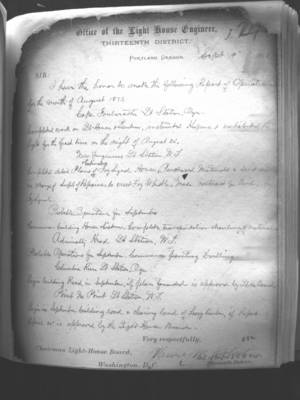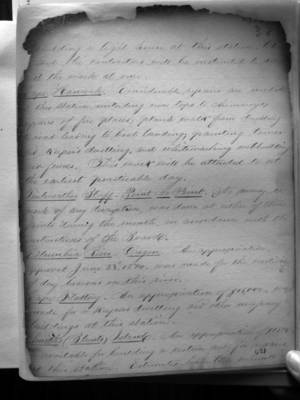Pages That Mention Point No Point
Vol 348 Engineer Reports 13th Dist. 1873 and 1874 CF Exhibted YB Discontinued
6
Office of the Light House Engineer Thirteenth District Portland, Oregon, Sept 9, 1873
SIR: I have the honor to make the following Report of Operations for the month of August 1873. Cape Foulweather Lt Station, Ogn Completed work on Lt-House & lantern, instructed keepers to exhibited the light for the first time on the night of August 20”. New Dungenness Lt Station, W.T. Completed detail plans and estimates of fog signal house. Purchased materials and sent men in charge of Supt of repairs, to erect fog whistle. Make contract for boiler for Fog Signal. Probable Operations for September Commence building house and cistern. Complete transportation and hauling of material. Admiralty Head Lt Station, W.T. Probable operations for September. Commence painting dwelling. Columbia River LH Station, Ogn Begin building Road in September, if plan forwarded is approved by Light House Board. Point no Point LH Station, W.T. Begin in September building road and clearing land of heavy timber, if Report of April 30th is approved by the Light-house Board. Very Respectfully, Chairman Light-House Board, Henry M Robert Washington DC Maj of Eng’rs & L.H. Eng’r
19
as the Engineer may deem proper to enable the Board to make the award. Foulweather Bluff – Point no Point. No survey or work of any description was done at either of these points during the month.
24
on the 11th of the month, and an Abstract of the same, with recommendations, submitted for the decisions of the Board. Foulweather Bluff – Point no Point. No survey, or work of any description, was done at either of these points during the month in accordance with instructions from the Board.
26
building a light house at this station. The ??? received the contractors will be instructed to ??? with the work at once. Cape Hancock. Considerable repairs are need at this station, including iron tops to chimneys; repairs of fire places; plank wall from dwelling to road leading to boat landing; painting tower and Keeper’s dwelling, and whitewashing outbuilding, and fences. This work will be attended to at the earliest practicable day. Foulweather Bluff-Point No Point. No survey, or work of any description, was don’t at either of these points during the month, in accordance with the instructions of the Board. Columbia River – Oregon. An appropriation approved June 23rd, 1874, was made for the erection of day beacons on this river. Cape Flattery. An appropriation of $1500 is available for building a custom and for repairs at this station. Lanitis??? (Blunts) Island. An appropriation of $1500 is available for building as cistern and for repairs at this station. Estimates have been submitted.
Coast Guard District narrative histories 1945
21
In the quite rapid succession, Umpqua River, Willapa Bay, Smith Island, Ediz Hook, Cape Arago, Cape Blanco, Point No Point, Point Wilson, and Yaquina Bay Lighthouses were built. In 1879, construction began on the Tillamook Rock Beacon.
Tillamook Rock Lighthouse was one of the most famous as well as one of the most exposed stations in the Lighthouse Service, set on a great precipitous rock lying a mile offshore from Tillamook Head on the Oregon Coast. A dark cloud of ill omen shadowed the station as, in the landing of the construction party, the superintendent was swept by a great wave into the sea and drowned. Almost insurmountable obstacles faced the engineers, for the entire top of the rock mass had to be blasted level to provide space for the lighthouse and its accompanying structures. Heavy seas continually washed over the Rock carrying away half finished foundations, equipment and endangering the lives of the entire work party. Although the light stood 133 feet above the water, on many occasions tremendous waves swept completely over the station carrying large fragments of rock which caused considerable damage to the station. On one such occasion, a rock weighting 135 pounds was hurled through the roof of the building and into the quarters below, causing extensive damage. Another time, the sea tossed a boulder through the lantern, extinguished the light and flooded the dwelling below.
West Point, built in 1881, Alki Point and Brown Point, built in 1887 and Destruction Island, built in 1891, were the next light stations to be erected. Here again, at Destruction Island, treacherous seas made landings difficult except in calm weather, so the "basket" and boom were again called upon for safe landings on the station. 14 other lighthouses were established in the Seattle District, the last being the Lim Kiln structure in 1914. Strangely enough, the Lime Kiln Lighthouse was the last light station in the District operating an oil lantern. An attempt was made to electrify the light by extending commercial power to the Station but the Power Company was unable to furnish sufficient current; in the same regard, poles had to be set in a solid rock and the cost and labor for this were almost prohibitive. A request was made for Headquarters' approval to install a power plant at the unit but this was not commensurate with Headquarters' policy so the light remained an incandescent oil vapor type. This type, familiarly known as i.o.v., gave good service although its range could not match that of the newer electric light. The old i.o.v. light came in two sizes and was approximately equivalent
-2-




